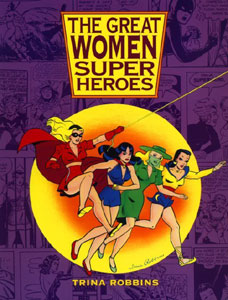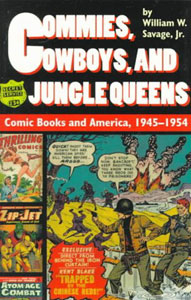|
|

|
| . |
|
|
|
|
|
|
| The
OFFICIAL OVERSTREET
COMIC
BOOK PRICE GUIDE
|

|
31st
Edition |
| by Robert M. Overstreet |
Paperback: 960 pages
31st edition
May 1, 2001
Crown Publishing
ISBN: 0609808206 |
$22.00

|
| The Bible of
the comic book industry for thirty-one years--and the essential tool for
collectors and investors!
Buy It. Use it. Become an
Expert |
|
|
|
This guide offers
the most complete record of existing comic books and graphic novels from
the 1800s to the present--indexed, illustrated, and priced according to
condition--and brings you more information than ever before, including
-
up-to-the-minute market reports
-
special exclusive features on
-
The Fantastic Four's fortieth
anniversary;
-
Wonder Woman's sixtieth anniversary;
-
legendary Silver Age artist
Murphy Anderson (Hawkman);
-
today's hottest comic creator,
Brian Michael Bendis (Ultimate Spider-Man)
-
original collectible cover art
by John K. Snyder III (Dr. Mid-Nite)
-
up-to-date directory of comic
book fan websites
-
tips about grading and caring
for your comics
-
more than 1,500 black-and-white
photographs and 33 color pages
-
The Overstreet Hall of Fame
About the Author
Robert M. Overstreet has
been collecting arrowheads since his childhood. He lives with his wife,
Carol, outside of Baltimore, Maryland. |
|
|
|
|
|
|
| TRINA
ROBBINS |

|
The
GREAT WOMEN SUPER HEROES |
| by Trina Robbins |
Paperback: 224 pages
Kitchen Sink Press
ISBN: 0878164812 |
$21.95
|
| Most
would be hard-pressed to name one female superhero besides Wonder Woman.
Robbins shows that there have been hundreds. When psychologist William
Marston (inventor of the lie detector, by the way) created WW in 1941,
her success opened the floodgates for such exotically named but generally
undistinguished imitations as Liberty Girl and Madame Strange. |
|
|
|
| The
'70s saw a rash of "women's lib" -influenced characters sporting what Robbins
terms a "slightly addled feminism." The backlash came with "bad girl" comics
starring buxom, scantily clad heroines appealing to an adolescent fanboy's
worst instincts. The '90s offer such alternatives for girl comics readers
as the punkster Tank Girl and spunky young Action Girl. Although some sense
of absurdity might have been appropriate to the task, Robbins is generally
straightforward in describing frequently silly characters. While she always
brings a distinctly feminist sensibility to the subject matter, she is
never strident, even about the most egregiously intelligence-insulting
conceptions, such as the Black Canary, who fights crime in high heels and
fishnets.
Gordon
Flagg
|
|
|
|
|
|
|
| WILLIAM
W. SAVAGE, Jr. |

|
COMMIES,
COWBOYS,
&
JUNGLE QUEENS
COMIC
BOOKS & AMERICA, 1945-1954 |
| by William W. Savage, Jr. |
Paperback: 164 pages
University Press of New England
ISBN: 0819563382 |
$14.95

|
Ingram
In the confusing decade
following World War II, comic books were all the rage. They treated such
issues as the atomic and hydrogen bombs, communism, and the Korean War,
and they offered heroes and heroines to deal with these problems. Using
five representative cartoon stories, historian William Savage looks at
the immense popularity of comic books and their impact on the American
public. |
|
|
|
The Washington
Post Book World, Dennis Drabelle
In Commies, Cowboys, and
Jungle Queens, William Savage ... argues that, in the decade between the
end of World War II and the comic book industry's adoption of a prissy
code at the height of the McCarthy era, the comics presented a distorted
but recognizable image of American mores. As a thesis, this may be a non-startler,
but Savage fleshes it out in interesting detail and accessible prose, embellished
with well-chosen (if dingy and cramped) reproductions of period strips. |
|
|
|
|
|
|
| ANDY
SMITH |

|
DRAWING
DYNAMIC COMICS |
| by Andy Smith |
Paperback: 144 pages
Watson-Guptill Pubns
ISBN: 0823003124 |
$19.95

|
| A fresh, up-to-date
approach to creating comics shows artists of all ages and talent levels
how to build basic figures into stylized characters, set them in action,
and add the backgrounds needed to complete the visual storytelling process. |
|
|
|
| Chapters include
instruction on basic shapes and perspective; human anatomy, figure drawing,
and stylizing the basic figure; the head and comic facial expressions;
and backgrounds and inking techniques. Terrific tips of the trade are provided
by prominent young professionals in the comic book industry who share their
insiders' overviews of the business, giving aspiring cartoonists a decided
edge in becoming savvy newcomers as they prepare to enter a very competitive
field.
About the Author
Andy Smith, whose own comic
books are published by Image Comics, has worked as a penciler, inker, and
art director for several top companies, including Marvel, DC, and Acclaim
Comics. He lives in Orlando, Florida. |
|
|
|
|


